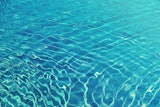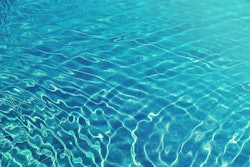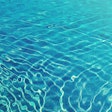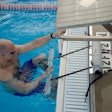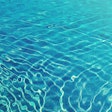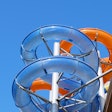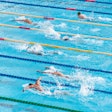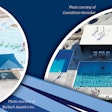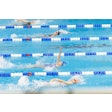
Every day, when Brian Peresie walks into his office at the University of Akron, he sees a piece of paper that he tacked on the wall during his first day as head women’s swimming and diving coach more than 10 years ago.
“It says, ‘Why is Akron swimming and diving the best program in the country? What am I doing to make it better?’ ” says Peresie. “I read that every day and it gets my mind flowing about the directions we need to go in.”
College swimming and diving coaches across the country are all asking themselves a similar question in 2025. How do they make their program the very best? In the face of new challenges such as name, image and likeness, roster limits and revenue sharing, Brigham Young University head swim coach Tamber McAllister put it best when she described the state of collegiate swimming and diving as, “The things we’re adapting to are different today.”
McAllister and Peresie both shared what the state of college swimming and diving looks like at their institutions. From the cutting-edge products giving their swimmers a leg up, to the ever-changing landscape of NIL, both the Zips and the Cougars are diving into the unknown with confidence and a love of the sport at the center of all they do.
 Photo courtesy of BYU
Photo courtesy of BYU
Products and facilities
Ocasek Natatorium is home to the Akron University women’s swimming and diving team. Says Peresie, “We’ve got a great 50-meter facility here that’s well maintained by the recreation department.”
The Zips recently installed a new Colorado Time Systems video board and allocated donated money to purchase an underwater camera system. These new high-tech products have allowed Peresie to take his team’s skills to the next level, as Akron has gone undefeated in the Mid-American Conference this season.
“At our last home competition, we put six underwater cameras in the pool, and then we had two above-water cameras that are on the side of the pool. As soon as you hit record, it starts all eight cameras simultaneously. Then, it automatically downloads to the video app,” Peresie explains. “It feels like the NFL, where you see them on the sidelines with their tablets and they’re going over plays. The swimmers can walk over from the blocks and all the videos have already been downloaded.”
McAllister is likewise experimenting with cutting-edge technology some 2,000 miles away at BYU’s Richards Building Pool in Provo, Utah, where she says, “Swimming is becoming more data-driven.”
Says McAllister, “We have a product that the swimmers use to monitor heart rate and energy levels throughout workouts. It’s a little Bluetooth monitor that straps on their goggles. We’ve gone all in to help evaluate where athletes are and how they can see their progress.”
Both coaches acknowledge that today’s student-athlete has a lot more information available at their fingertips, and more than ever, they want to understand the thought process behind their training. Technology innovations, such as cameras and goggle monitors, can bridge the gap between athletes’ ownership of their own training and coaches’ institutional knowledge of the sport.
 Photo courtesy of BYU
Photo courtesy of BYU
Goal-oriented coaching
McAllister and Peresie have big hopes and goals for what their talented swimmers, well-maintained facilities and cutting-edge technology can help them achieve. Both admit that, in the long run, their goals are to compete at the highest level, whether that means sending swimmers to the NCAA championships or the U.S. Olympic Swimming and Diving Trials.
“When I took over the program here, the team had just finished eighth place in the conference — dead last,” explains Peresie. “My first year, we went from being the worst to the best. Then, we strung together a bunch of championships from 2014 to 2020. We sent swimmers to NCAA championships starting in year three.”
To top it all off, the Zips cheered on one of their own at the Paris 2024 Paralympic Games. Senior Grace Nuhfer won silver in the S13 100 butterfly.
Adds BYU’s McAllister, “To me, success looks like being consistent at the national level, taking athletes to the NCAA championships and being competitive.”
To get there, McAllister credits tremendous administrative support. She explains that her administration’s honesty and openness are essential to the student-athlete’s success, especially in times of change.
Team culture is also essential for success, according to Peresie. “I’m focused on the process and trying to create a good environment day to day, with the culture of our team, with feedback that we can give, every little thing that goes into each day,” he says. “One hundred small improvements add up to one big time drop. We’re going to achieve our goals if we continue to find as many ways to improve as we can.”
 Photo courtesy of Akron Athletics (MAC Sports)
Photo courtesy of Akron Athletics (MAC Sports)
Continuous improvement
No one ever said the path to becoming NCAA champions would be easy, let alone the task of maintaining a successful, non-revenue-generating team. And while both McAllister and Peresie allow that they don’t have all the answers for improving collegiate aquatics, they do have some strong suggestions.
“We need to find a way to be TV-ready, like exciting to watch. We need to find a way to appeal to a larger audience,” Peresie says.
McAllister agrees, saying, “I think that has been a conversation nationally, trying to make swim and dive relevant, not just an experience every four years at the Olympics. Why can’t we make college swimming exciting and fan-engaging? That’s a huge discussion at the college level.”
However, there are obstacles for swim and dive programs beyond media and fan engagement. Says Peresie, “Retaining female swim coaches is a challenge that we have to address. We need to seriously look at how we can improve that.”
As a female swim coach who had defied the odds, McAllister adds, “You don’t have college athletics without having change and constant maneuvering.” And one of those changes facing college swimming and diving programs today is the rise of NIL and roster limits. The state of collegiate aquatics is inseparable from this topic, as teams across the country stare into the murky waters of the future.
Beginning in 2021, college student-athletes were legally allowed to earn money for their name, image and likeness, and that historic change led to a landmark court case, House v. NCAA. Grant House, a former Arizona State swimmer, argued that the NCAA was violating antitrust laws by denying athletes NIL payments prior to 2021. Now, four years later, athletes who competed in the NCAA from 2016 to 2024 are preparing to see their payday, or perhaps more accurately, their back-payday.
“I think the biggest impact is going to be felt at Power Four schools. They’re going to get more money. They’re already getting a lot, but now they’re getting more. I don’t think that is going to change much,” Peresie says.
 Photo courtesy of Akron Athletics (MAC Sports)
Photo courtesy of Akron Athletics (MAC Sports)
It is the plight of the nonrevenue sport that an estimated 80% to 90% of NIL funding at any school will be spent on football and men’s basketball. For swimming in particular, McAllister says, “It’s not nearly at the same level as some other sports.”
College athletic departments across the country have been impacted by these changes. At the University of Iowa, nonrevenue sports, including men’s swimming and diving, faced a harsh reality a few years ago.
“There are a lot of Olympic sports people who are upset about the House bill,” says University of Iowa alum Matt Purdy, a member of Save Hawkeye Sports. “Yes, people are going to get paid, but you’re taking swimming rosters and trimming them down, and taking four to six people off any given swim team.”
Purdy’s son, Ryan, swam for the Hawkeyes his freshman year, but was devastated upon learning that Iowa planned to eliminate the men’s swim team in the face of low revenue, NIL expectations and roster cuts. Says the elder Purdy, “Does that money start to cause more problems for nonrevenue sports? Do you keep losing sports like the small teams without a huge budget because they have to pay for basketball and football?”
Peresie and McAllister have yet to see such dramatic shifts as a result of the legalization of NIL or the impact of revenue sharing at their respective universities. However, McAllister knows that NIL deals are slowly infiltrating her team.
“We definitely have some,” she says. “They are a lot more minimal than the ones you hear about at a large scale.
“The athlete’s individual deals are something that they are seeking out. We as coaches don’t have a lot of direct impact on that.”
And while BYU swimmers aren’t signing star quarterback-scale NIL deals with national brands, they are connecting with opportunities in their local community. Says McAllister, “One member of the team recently went to a jewelry store to get his watch worked on, and he was going to buy a ring from the store, as he wanted to get engaged soon, so he worked with them on an NIL deal to get a discount on his fiancé’s ring. It’s a minimal deal, but it makes a difference in their lives.”
“It’s great that the student-athletes can benefit and be a good example in the community,” she adds.
While student-athletes focus on their newfound NIL opportunities, coaches are focused on an inevitable future: roster cuts. “Obviously, NIL is going to affect roster limits,” McAllister says. “That is a national-level issue.”
“We’ve historically been right around 30, which is the limit currently for men’s and women’s programs,” Peresie says. “Some programs are going to have to make some tough decisions. The transfer portal could be hopping once the season is over.”
Peresie even sees a way roster cuts can enhance his talent pool. “The talent is going to trickle down,” he says, “and that is an opportunity for Akron to acquire a higher level of talent than it has in the past.”
BYU may have also escaped unscathed from roster cuts thus far. “We had a large graduating class of COVID seniors, so we have 21 athletes graduating,” McAllister says. “Knowing the national average is going to put everybody at 30, BYU has done a great job of keeping us with as high numbers as possible. They’ve asked us to lower our women’s numbers to that level, and the men will be lowered the same amount that the women were lowered. It’s a handful on each side.”
Even the athletes are feeling the roster limit squeeze. Purdy, whose son Ryan ultimately finished his collegiate swimming career at Arizona, says, “Arizona men’s swim had 30 men a few years ago. Now they are down to 24.”
Says Peresie, “Trying to navigate the landscape of what the NCAA is going to look like over the next five years, I don’t know that anybody can predict exactly what it’s going to be, though we keep getting hints.”
For Peresie and McAllister, their optimistic outlooks and impressive team performances indicate that they won’t be backing down from the sport any time soon. They know that swimming and diving are sports that so many people care about — flashy NIL deals or not — and both teams are focused on competing at the highest level for years to come.
Purdy’s final question rings true for all collegiate aquatics programs fighting for a seat at the table: “Is it sustainable?”















